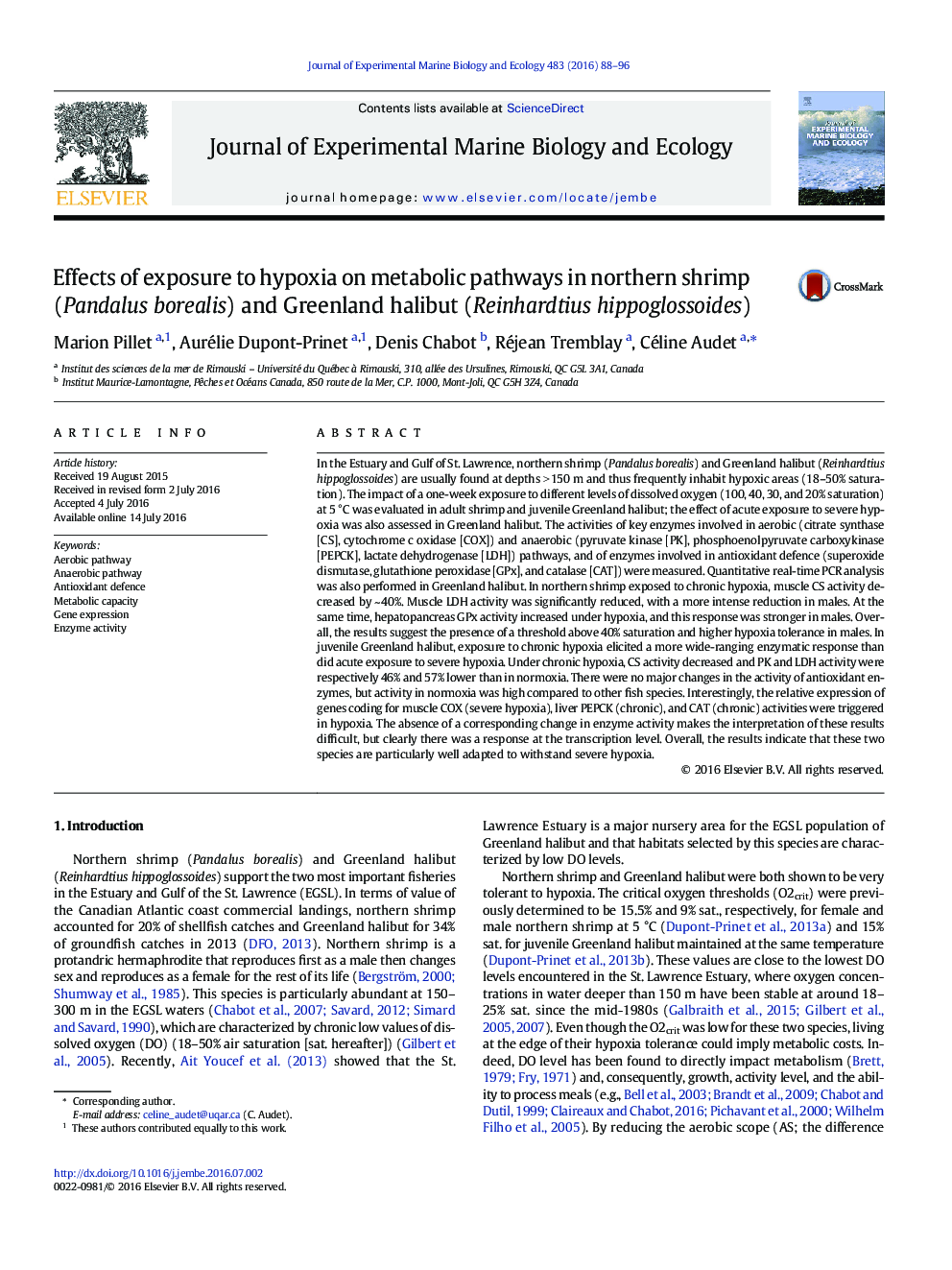| کد مقاله | کد نشریه | سال انتشار | مقاله انگلیسی | نسخه تمام متن |
|---|---|---|---|---|
| 4395220 | 1618392 | 2016 | 9 صفحه PDF | دانلود رایگان |
عنوان انگلیسی مقاله ISI
Effects of exposure to hypoxia on metabolic pathways in northern shrimp (Pandalus borealis) and Greenland halibut (Reinhardtius hippoglossoides)
دانلود مقاله + سفارش ترجمه
دانلود مقاله ISI انگلیسی
رایگان برای ایرانیان
کلمات کلیدی
موضوعات مرتبط
علوم زیستی و بیوفناوری
علوم کشاورزی و بیولوژیک
علوم آبزیان
پیش نمایش صفحه اول مقاله

چکیده انگلیسی
In the Estuary and Gulf of St. Lawrence, northern shrimp (Pandalus borealis) and Greenland halibut (Reinhardtius hippoglossoides) are usually found at depths > 150 m and thus frequently inhabit hypoxic areas (18-50% saturation). The impact of a one-week exposure to different levels of dissolved oxygen (100, 40, 30, and 20% saturation) at 5 °C was evaluated in adult shrimp and juvenile Greenland halibut; the effect of acute exposure to severe hypoxia was also assessed in Greenland halibut. The activities of key enzymes involved in aerobic (citrate synthase [CS], cytochrome c oxidase [COX]) and anaerobic (pyruvate kinase [PK], phosphoenolpyruvate carboxykinase [PEPCK], lactate dehydrogenase [LDH]) pathways, and of enzymes involved in antioxidant defence (superoxide dismutase, glutathione peroxidase [GPx], and catalase [CAT]) were measured. Quantitative real-time PCR analysis was also performed in Greenland halibut. In northern shrimp exposed to chronic hypoxia, muscle CS activity decreased by ~ 40%. Muscle LDH activity was significantly reduced, with a more intense reduction in males. At the same time, hepatopancreas GPx activity increased under hypoxia, and this response was stronger in males. Overall, the results suggest the presence of a threshold above 40% saturation and higher hypoxia tolerance in males. In juvenile Greenland halibut, exposure to chronic hypoxia elicited a more wide-ranging enzymatic response than did acute exposure to severe hypoxia. Under chronic hypoxia, CS activity decreased and PK and LDH activity were respectively 46% and 57% lower than in normoxia. There were no major changes in the activity of antioxidant enzymes, but activity in normoxia was high compared to other fish species. Interestingly, the relative expression of genes coding for muscle COX (severe hypoxia), liver PEPCK (chronic), and CAT (chronic) activities were triggered in hypoxia. The absence of a corresponding change in enzyme activity makes the interpretation of these results difficult, but clearly there was a response at the transcription level. Overall, the results indicate that these two species are particularly well adapted to withstand severe hypoxia.
ناشر
Database: Elsevier - ScienceDirect (ساینس دایرکت)
Journal: Journal of Experimental Marine Biology and Ecology - Volume 483, October 2016, Pages 88-96
Journal: Journal of Experimental Marine Biology and Ecology - Volume 483, October 2016, Pages 88-96
نویسندگان
Marion Pillet, Aurélie Dupont-Prinet, Denis Chabot, Réjean Tremblay, Céline Audet,